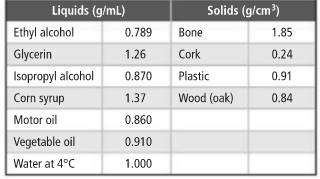
Concept explainers
Interpretation:
The density values given in the table for several common solids and liquids needs to be calculated. The layering of these solids and liquids needs to be explained when placed in a
Concept introduction:
Density of a sample of matter or an object is equal to the mass of the sample divided by the volume of the sample.
Answer to Problem 65A
The order of layering of the given solids and liquids form bottom to the top will be bone, corn syrup, glycerin, water, plastic, vegetable oil, isopropyl alcohol, motor oil, wood, ethyl alcohol and then cork.
Explanation of Solution
Given Information:

The liquid or solid whose density is highest will be at the bottom of the large graduated cylinder while the liquid having least density will be present at the top. Thus, the order of layering form bottom to the top will be bone, corn syrup, glycerin, water, plastic, vegetable oil, isopropyl alcohol, motor oil, wood, ethyl alcohol and then cork.
The order of layering of the given solids and liquids form bottom to the top will be bone, corn syrup, glycerin, water, plastic, vegetable oil, isopropyl alcohol, motor oil, wood, ethyl alcohol and then cork.
Chapter 2 Solutions
Chemistry: Matter and Change
Additional Science Textbook Solutions
Chemistry: A Molecular Approach
Introductory Chemistry (5th Edition) (Standalone Book)
Chemistry: The Central Science (14th Edition)
General, Organic, and Biological Chemistry (3rd Edition)
General Chemistry: Principles and Modern Applications (11th Edition)
Essential Organic Chemistry (3rd Edition)
 ChemistryChemistryISBN:9781305957404Author:Steven S. Zumdahl, Susan A. Zumdahl, Donald J. DeCostePublisher:Cengage Learning
ChemistryChemistryISBN:9781305957404Author:Steven S. Zumdahl, Susan A. Zumdahl, Donald J. DeCostePublisher:Cengage Learning ChemistryChemistryISBN:9781259911156Author:Raymond Chang Dr., Jason Overby ProfessorPublisher:McGraw-Hill Education
ChemistryChemistryISBN:9781259911156Author:Raymond Chang Dr., Jason Overby ProfessorPublisher:McGraw-Hill Education Principles of Instrumental AnalysisChemistryISBN:9781305577213Author:Douglas A. Skoog, F. James Holler, Stanley R. CrouchPublisher:Cengage Learning
Principles of Instrumental AnalysisChemistryISBN:9781305577213Author:Douglas A. Skoog, F. James Holler, Stanley R. CrouchPublisher:Cengage Learning Organic ChemistryChemistryISBN:9780078021558Author:Janice Gorzynski Smith Dr.Publisher:McGraw-Hill Education
Organic ChemistryChemistryISBN:9780078021558Author:Janice Gorzynski Smith Dr.Publisher:McGraw-Hill Education Chemistry: Principles and ReactionsChemistryISBN:9781305079373Author:William L. Masterton, Cecile N. HurleyPublisher:Cengage Learning
Chemistry: Principles and ReactionsChemistryISBN:9781305079373Author:William L. Masterton, Cecile N. HurleyPublisher:Cengage Learning Elementary Principles of Chemical Processes, Bind...ChemistryISBN:9781118431221Author:Richard M. Felder, Ronald W. Rousseau, Lisa G. BullardPublisher:WILEY
Elementary Principles of Chemical Processes, Bind...ChemistryISBN:9781118431221Author:Richard M. Felder, Ronald W. Rousseau, Lisa G. BullardPublisher:WILEY





